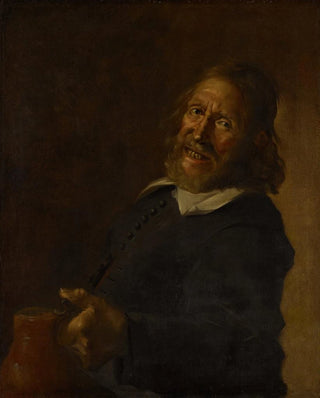Art print | The Jester - Frans Hals School


View from behind

Frame (optional)
In the fascinating world of Dutch baroque art, "The Jester" stands out as an emblematic artwork that captures the very essence of joie de vivre. This painting, attributed to the School of Frans Hals, evokes a lively and warm atmosphere, where the central character, with his radiant smile, seems to invite the viewer to share a moment of conviviality. Light plays a crucial role in this composition, illuminating the jester's face and creating a dynamic interplay between shadows and highlights that enhances the expressiveness of the piece. By contemplating this art print, the observer is transported to a world where art and life intersect, offering an immersive and captivating experience.
Style and uniqueness of the work
The style of "The Jester" is characterized by an exceptional mastery of pictorial technique. The color palette, rich and vibrant, demonstrates the artist's skill in playing with nuances to create effects of depth and movement. The brushstrokes, both precise and bold, bring the character to life, almost as if emerging from the canvas. This approach, typical of the School of Frans Hals, highlights traits of great expressiveness, making the jester both accessible and mysterious. The composition, focused on the character's face, immediately draws the eye and invites attentive contemplation. Every detail, from the smile to the light reflections in the eyes, is carefully crafted, reflecting a concern for realism that transcends a simple portrait to become a true study of character.
The artist and his influence
Frans Hals, an iconic figure of the 17th century, profoundly influenced the history of Dutch painting. His innovative approach to human representation influenced many artists, both contemporaries and successors. His ability to capture the moment, to freeze a fleeting emotion on the canvas, is one of the reasons he is considered a master of portraiture. Hals transcended mere visual rendering to offer a genuine emotional experience to the viewer. "The Jester," although attributed to his school, bears witness to this undeniable influence, where lively expression and realism intertwine to create

Matte finish

View from behind

Frame (optional)
In the fascinating world of Dutch baroque art, "The Jester" stands out as an emblematic artwork that captures the very essence of joie de vivre. This painting, attributed to the School of Frans Hals, evokes a lively and warm atmosphere, where the central character, with his radiant smile, seems to invite the viewer to share a moment of conviviality. Light plays a crucial role in this composition, illuminating the jester's face and creating a dynamic interplay between shadows and highlights that enhances the expressiveness of the piece. By contemplating this art print, the observer is transported to a world where art and life intersect, offering an immersive and captivating experience.
Style and uniqueness of the work
The style of "The Jester" is characterized by an exceptional mastery of pictorial technique. The color palette, rich and vibrant, demonstrates the artist's skill in playing with nuances to create effects of depth and movement. The brushstrokes, both precise and bold, bring the character to life, almost as if emerging from the canvas. This approach, typical of the School of Frans Hals, highlights traits of great expressiveness, making the jester both accessible and mysterious. The composition, focused on the character's face, immediately draws the eye and invites attentive contemplation. Every detail, from the smile to the light reflections in the eyes, is carefully crafted, reflecting a concern for realism that transcends a simple portrait to become a true study of character.
The artist and his influence
Frans Hals, an iconic figure of the 17th century, profoundly influenced the history of Dutch painting. His innovative approach to human representation influenced many artists, both contemporaries and successors. His ability to capture the moment, to freeze a fleeting emotion on the canvas, is one of the reasons he is considered a master of portraiture. Hals transcended mere visual rendering to offer a genuine emotional experience to the viewer. "The Jester," although attributed to his school, bears witness to this undeniable influence, where lively expression and realism intertwine to create






